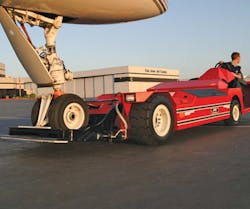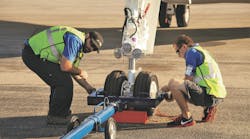A lot of attention is paid in the news media when an airliner sustains ground damage, especially if it’s significant, like the aircraft that rolled backwards into a building at an airport in Rome because it wasn’t properly chocked. Not nearly as much attention is paid to general aviation and corporate aircraft when they sustain ground damage but, unfortunately, damage on the ground to aircraft of all types is much too routine.
And it can be very costly, time-consuming, and not great for the professional careers of those responsible. The Flight Safety Foundation, estimates that “27,000 ramp accidents and incidents — one per 1,000 departures — occur worldwide every year. About 243,000 people are injured each year in these accidents and incidents; the injury rate is nine per 1,000 departures.” Everyone involved in aviation plays a role but this article is about what maintenance professionals can do when the aircraft is under their custody and control.
Common scenario
A recent example that came to my attention illustrates a common scenario. A mechanic repositioning a corporate aircraft in a hangar struck an adjacent aircraft. In this case, the tug he was using to reposition the aircraft struck the other airplane in the fuselage just aft of the wing. On the surface, the damage did not look that bad. Unfortunately, the internal structural damage was significant and required the aircraft to be out of service for three months.
I don’t know how that particular accident occurred, and I won’t speculate here, but it highlights one of the most common situations that can get mechanics in trouble: maneuvering in tight spaces. Of course, if he was maneuvering in a tight space under time constraints that just adds to the problem. And as we all know, it’s a rare day that mechanics aren’t under time pressure to get all their tasks accomplished.
So what can be done?
So, what can be done to prevent hangar rash? These are a few of my tips:
- Follow your company’s procedures. Yes, we’ve all heard that before but it really is the first step in assuring safe movement of aircraft and preventing this type of ground damage.
- Check all the equipment that you will be using to ensure it’s in good working order. Tow bars are notoriously neglected and abused and are known to fail.
- Check the brakes on any equipment you will be using, including the emergency brake. Even if you’re not the first person using the equipment.
- In tight quarters, make sure you have enough people to see the four corners of the aircraft. Yes, this can be tough to do on a busy day but even a scratch to an aircraft’s skin can result in mountains of paperwork and much greater delays. So if you don’t have enough people and quarters are tight, don't move the aircraft.
- Watch Flight Safety Foundation’s three-part video series “Best Practices for Safely Towing Aircraft”. The videos are short, free, and great reminders of safety precautions that should be taken. They are available at: http://flightsafety.org/archives-and-resources/ground-accident-prevention-gap




